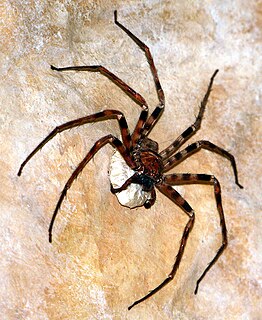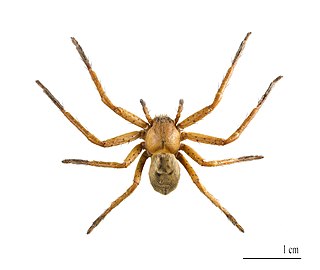
Huntsman spiders, members of the family Sparassidae, are known by this name because of their speed and mode of hunting. They are also called giant crab spiders because of their size and appearance. Larger species sometimes are referred to as wood spiders, because of their preference for woody places. In southern Africa the genus Palystes are known as rain spiders or lizard-eating spiders. Commonly they are confused with baboon spiders from the Mygalomorphae infraorder, which are not closely related.
Benoy Krishna Tikader (1928-1994) was an Indian arachnologist and zoologist and a leading expert on Indian spiders in his time. He worked in the Zoological Survey of India and published the Handbook of Indian Spiders in 1987. The book describes 40 families and 1066 species of India, many of which were described by Tikader himself. The handbook is a guide to all arachnids including scorpions, and not just spiders. He was also a popular scientific author in his native language of Bengali, and was the author of Banglar Makorsha for the layman.

Micrommata virescens, common name green huntsman spider, is a species of huntsman spiders belonging to the family Sparassidae.

Heteropoda is a genus of spiders in the family Sparassidae, the huntsman spiders. They are mainly distributed in tropical Asia and Australia, while at least one species, H. venatoria, has a cosmopolitan distribution, and H. variegata occurs in the Mediterranean.

The giant huntsman spider, found in Laos, is a species of huntsman spider (Sparassidae), a family of large, fast spiders that actively hunt down prey. It is considered the world's largest spider by leg span, which can reach up to 30 cm (1 ft).

Olios argelasius is a species of huntsman spider found in the Mediterranean Basin. It was first described by Charles Athanase Walckenaer in 1805.
David B. Hirst is an arachnologist previously based at the South Australian Museum in Adelaide. He left the Museum on 22 February 2011. He has described more than 40 species and genera in the huntsman spider family, Sparassidae, and was regularly called on by New Zealand authorities to identify huntsman spiders that entered their country.

Olios is the largest genus of huntsman spiders, containing 250 species. They are found throughout the world, with most species occurring in hot countries. The genus was first described by Charles Athanase Walckenaer in 1837.
Olios suavis is a spider species found in Cyprus, Israel and Egypt.
Olios greeni, is a species of spider of the genus Olios. It is endemic to Sri Lanka.
Olios hirtus, is a species of spider of the genus Olios. It is endemic to Sri Lanka.

Olios lamarcki, is a species of spider of the genus Olios. It is found in Madagascar to Sri Lanka and India. The subspecies O. lamarcki taprobanicus is endemic to Sri Lanka.

Olios milleti, is a species of spider of the genus Olios. It is native to India and Sri Lanka. According to SpiderID, Olios milleti is most often sighted outdoors during the month of February.
Olios senilis, is a species of spider of the genus Olios. It is native to India and Sri Lanka.

Alireza Zamani is an Iranian arachnologist and taxonomist.
Rhitymna is a genus of huntsman spiders described in 1897 by Eugène Simon. Members of this genus can be distinguished by a number of characteristics, but it is most often confused with Olios species, many of which also have the Y-shaped pattern on the dorsal opisthosoma.

Curicaberis is a genus of huntsman spiders that was first described by C. A. Rheims in 2015.
Vindullus is a genus of huntsman spiders that was first described by Eugène Louis Simon in 1880. Though often considered a synonym of Olios, it has been validated as its own genus.

Olios giganteus is a species of giant crab spider in the family Sparassidae. It is found in the United States and Mexico.









